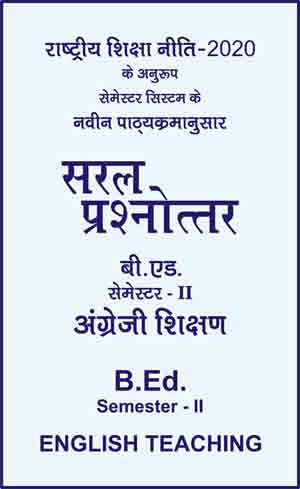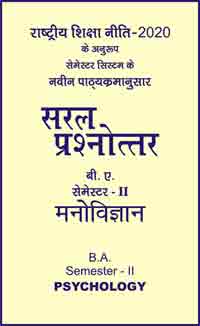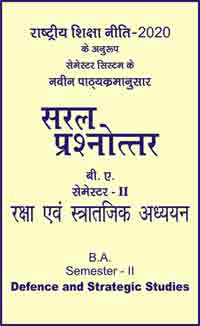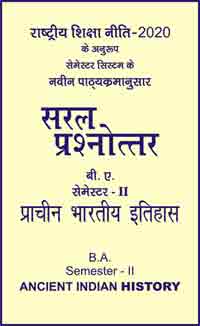|
बी एड - एम एड >> बीएड सेमेस्टर-2 अंग्रेजी शिक्षण बीएड सेमेस्टर-2 अंग्रेजी शिक्षणसरल प्रश्नोत्तर समूह
|
5 पाठक हैं |
||||||
बीएड सेमेस्टर-2 अंग्रेजी शिक्षण - सरल प्रश्नोत्तर
Question- Describe the meaning and scope of three language formula in the light of Indian society.
Ans.
A 50 year old controversy got a new lease of life recently when a paragraph in the Draft New Education Policy 2019 referred to the mandatory teaching of Hindi in states where Hindi is not spoken.
This was a reiteration of the central government’s three-language formula, but it set off a storm in Tamil Nadu, which stoutly opposes any attempt to impose Hindi and adheres to a two-language formula. The Union Government sought to neutralise the hostile reaction by dropping the controversial reference to Hindi.
What is the Formula ? - It is commonly understood that the three language referred to are Hindi, English and the regional language of the respective states. Though the teaching of Hindi across the country was part of a long standing system, it was crystallised into already in use as the media of education in the primary and secondary stages. In addition, it said “At the secondary stage, state government should adopt and vigorously implement the three-language formula, which includes the study of a modern Indian language, preferably one of the southern language apart from Hindi and English in the Hindi-speaking states.” In the non-Hindi speaking states, Hindi should be studied along with the regional language and English. It added, “suitable courses in Hindi and / or English should also be available in universities and colleges with a view to improving the proficiency of students in these language up to the prescribed university standards.”
On promotion of Hindi the NPE 1968 said every effort should be made to promote the language and that “In developing Hindi as the link language, due care should be taken to ensure that it will serve as provided for the Article 351 of the constitution as a medium of expression for all the elements of the composite culture of India. The establishment in non-Hindi state of colleges and other institution of higher education which use Hindi, as the medium of education should be encouraged.” Incidentally, the NPE 1986 made no change in the 1988 policy on the three-language formula and the promotion of Hindi and repeated it verbatim.
Scope of the Three-language Formula - The first recommendation for a three-language policy was made by the University Education Commission in 1948-49 which did not find the requirement to study three-language to be an extravagance, citing the precedents of other multilingual nations such as the Netherlands and Switzerland. While accepting that modern standard Hindi was itself a minority language and had no superiority over others such as Kannada, Telugu, Tamil, Marathi, Bengali, Punjabi, Malayalam and Gujrati of which had a longer history and greater body of literature, the commission still foresaw Hindi as eventually replacing English as the means by which every Indian state may participate in the Federal functions.
The education commission of 1964-66 recommended a modified or graduated three-language formula. Following some debate was adopted by the Indian Parliament in 1968, the 1986 National Policy on Education reiterated the 1988 formula.
The central government released a draft NPE, a report prepared by a committee headed by space scientist K. Kasturirangan. Its reference to mandatory teaching of Hindi in non-Hindi speaking states set off a political storm in Tamil Nadu, which is traditionally opposed to the compulsory study of Hindi. The draft had a sentence on flexibility on choice of language for school students. Those who wished to change the three-language may do so in Grade 6, it said “so long as the study of three-language by students in Hindi-speaking states would continue to include Hindi and English and one of the modern Indian language the regional language, Hindi and English.
What is the back drop to the Hindi Imposition Row ? - The state has been traditionally opposed to any attempt to introduce Hindi as a compulsory language of learning or administration. The origin of the linguistic row, however goes back to the debate on official language. In the constituent Assembly, Hindi was voted as the official language by a single vote. However it added that English would continue to be used as an associate official language for 15 years. The official Language Act came into effect on the expiry of this 15 year period in 1965. This was the background in which the anti-Hindi language took place. However, as early as in 1959 Pt. Jawaharlal Nehru had gives an assurance in parliament that English would continue to be in use as long as non-Hindi speaking people wanted it.
Advantages of Three-language Formula - When the three-language formula was adopted the idea behind it was to use it as strategy for creating a space for the students to study foreign languages, classical languages and proximate languages. While Sanskrit could be used as a classical language the
states were given a complete freedom to choose languages in their education system. The UNESCO declaration highlights that the best medium for the education of a child is his / her mother tongue. Keeping the basic structure and spirit of this three-language formula intact the school can adopt any language. There is absolutely no restriction in this. Education in a child’s mother tongue will ensure better participation and richer interaction and transaction in the classrooms. This will lead to better outcomes of children as far as learning is concerned.
Disadvantages of Three-language Formula - Like every coin has to sides, similarly, the three-language formula has its flip side too. This might lead to heavy language burden on the students. Most of the times, a lot of school can not afford the resources for providing additional language faculties as well as teaching materials. The KV students are at a clear cut backfoot in the entire situation as this has become more of a depate between Geraman and Sanskrit. These are approximately 80,000 students in KV from class 5th to 8th studying German. The decision of the HRD Minister Smt. Smriti Irani has left them with nothing in hand. The decision to discard German as the third language choice in KVs and introducing a modern India language or Sanskrit will be a major blow to these students as well as the teachers, who will be left jobless.
While this is a debate rather a controversy, more about German vs. Sanskrit, rather than any other language the people at the set back are the students, half-way through the education in these languages and also the teachers who will be left unemployed because of this.
|
|||||













